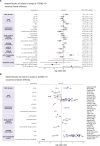Exploratory study of the global intent to accept COVID-19 vaccinations
- PMID: 35602227
- PMCID: PMC9053214
- DOI: 10.1038/s43856-021-00027-x
Exploratory study of the global intent to accept COVID-19 vaccinations
Abstract
Background: As the world begins the rollout of multiple COVID-19 vaccines, pandemic exit strategies hinge on widespread acceptance of these vaccines. In this study, we perform a large-scale global exploratory study to examine the levels of COVID-19 vaccine acceptance and explore sociodemographic determinants of acceptance.
Methods: Between October 31, 2020 and December 15, 2020, 26,759 individuals were surveyed across 32 countries via nationally representative survey designs. Bayesian methods are used to estimate COVID-19 vaccination acceptance and explore the sociodemographic determinants of uptake, as well as the link between self-reported health and faith in the government's handling of the pandemic and acceptance.
Results: Here we show that intent to accept a COVID-19 vaccine is low in Lebanon, France, Croatia, and Serbia and there is population-level polarisation in acceptance in Poland and Pakistan. Averaged across all countries, being male, over 65, having a high level of education, and believing that the government is handling the pandemic well are associated with increased stated acceptance, but there are country-specific deviations. A belief that the government is handling the pandemic well in Brazil and the United States is associated with lower vaccination intent. In the United Kingdom, we find that approval of the first COVID-19 vaccine in December 2020 did not appear to have an impact on the UK's vaccine acceptance, though as rollout has continued into 2021, the UK's uptake exceeds stated intent in large-scale surveys conducted before rollout.
Conclusions: Identifying factors that may modulate uptake of novel COVID-19 vaccines can inform effective immunisation programmes and policies. Differential stated intent to accept vaccines between socio-demographic groups may yield insights into the specific causes of low confidence and may suggest and inform targeted communication policies to boost confidence.
Keywords: Epidemiology; Infectious diseases.
© The Author(s) 2021.
Conflict of interest statement
Competing interestsAdF and HJL are involved in Vaccine Confidence Project collaborative grants with GlaxoSmithKline and Janssen Pharmaceutica outside the submitted work. HJL has also received honoraria as a member of the Merck Vaccine Confidence Advisory Board and GlaxoSmithKline advisory roundtables. HJL is a member of the Merck Vaccine Confidence Advisory Board.
Figures



References
-
- Larson, H. J., de Figueiredo, A., Karafillakis, E. & Rawal, M. State of vaccine confidence in the EU 2018. https://ec.europa.eu/health/sites/health/files/vaccination/docs/2018_vac... (2018).
-
- de Figueiredo, A., Karafillakis, E., Larson, H. State of vaccine confidence in the EU and UK 2020. https://ec.europa.eu/health/sites/health/files/vaccination/docs/2020_con... (2020).
-
- Bernal, J. L. et al. Effectiveness of COVID-19 vaccines against the B.1.617.2 variant. Medrxiv (pre-print) (2021).
LinkOut - more resources
Full Text Sources
Research Materials

